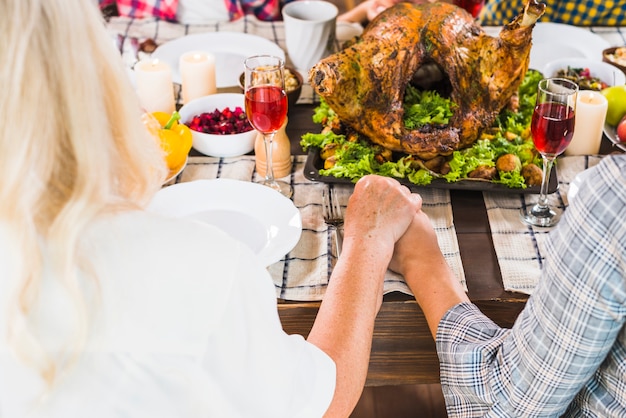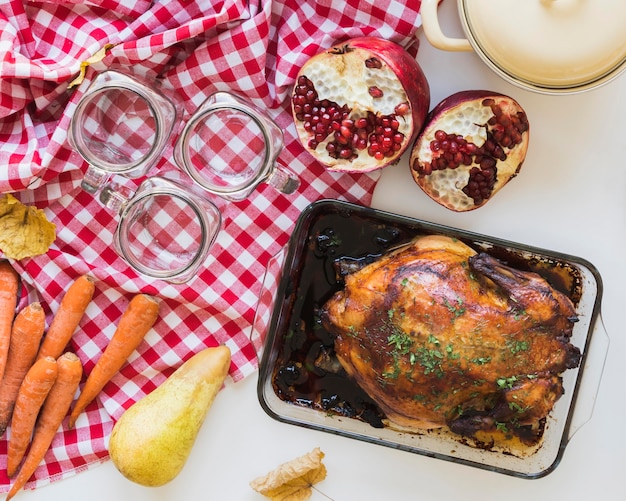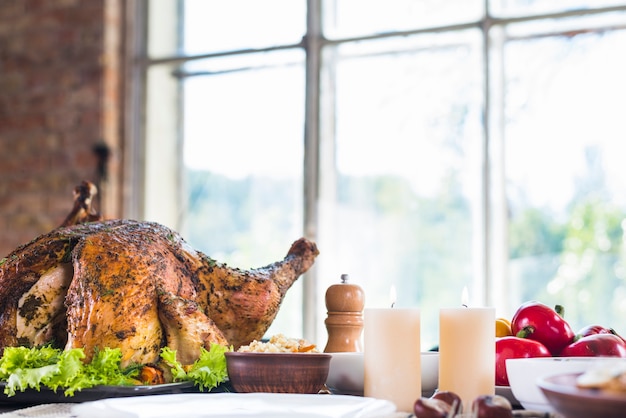You've got yourself a magnificent 21-pound turkey, eh? You're likely thinking, "How on earth do I cook this behemoth?" Believe me, I've been there too. I've faced turkeys of all sizes, and I'm here to guide you through this culinary adventure. This isn't just about cooking a bird; it's about creating memories, sharing laughter, and, of course, crafting a delicious feast that everyone will relish. Let's break down the process, bit by bit, and make this a truly unforgettable experience.
(Part 1) The Pre-Game: Preparing Your Turkey

The secret to a flawlessly cooked turkey? It starts before the oven even heats up, my friend. It's all about careful preparation, like setting the stage for a grand performance. We're not rushing, we're taking our time and paying attention to the details.
1. Thaw It Out
First things first, we need to defrost that big bird. You've got a few options here, each with its own pros and cons.
- The Fridge Method: This is the classic, tried-and-true method. It's the gentlest on the turkey, allowing it to defrost slowly and evenly. Just pop the turkey in the fridge, and let it chill out. Allow about 24 hours per 5 pounds of turkey. So, for a 21-pounder, you're looking at about 4 days. Patience is key here! The fridge method ensures the turkey stays at a safe temperature throughout the thawing process, minimizing the risk of bacterial growth.
- The Cold Water Method: Need to speed things up? Submerge the turkey in cold water. Change the water every 30 minutes to keep it cold. A 21-pound turkey could take around 5-7 hours this way. Just be sure to keep the turkey fully submerged, or you'll have a big ol' mess on your hands. The cold water method is a faster option, but remember to keep a close eye on the water temperature and change it regularly to prevent any bacterial growth.
- The Microwave Method: This one's a bit more risky, and I wouldn't recommend it for a large turkey. It's better suited for smaller portions. Check your microwave manual for instructions on thawing meat and follow them carefully. It's essential to understand the potential hazards of uneven thawing when using the microwave method, as it can create warm spots that encourage bacteria growth.
Remember, a properly thawed turkey is the foundation for a delicious meal. Choose the method that best suits your time constraints and ensures a safe thawing process.
2. Get That Bird Clean
Once your turkey is thawed, give it a good rinse. It's not about a spa treatment, but a quick wash to remove any loose bits or debris. Then, pat the bird dry with paper towels. No one wants a soggy turkey!
3. Stuff It or Don't Stuff It?
Now, comes the decision: stuff or don't stuff? This is a matter of personal preference. I prefer to stuff the turkey separately, as it allows for more even cooking and avoids potential safety concerns. However, if you're set on stuffing the bird, be sure to use a food thermometer to ensure the stuffing reaches a safe internal temperature of 165°F. There's nothing worse than a food poisoning scare on Thanksgiving! If you opt for stuffing the bird, make sure to stuff it loosely and give it plenty of room to breathe, allowing for proper heat distribution.
Remember, whether you stuff the turkey or not, always use a food thermometer to ensure it's cooked through. food safety should always be a top priority.
4. The Secret Weapon: Brining
Here's where we introduce a game-changer: brining! Brining is the art of soaking the turkey in a salty solution, which helps to keep the meat moist and incredibly juicy. You've got two main options:
- Dry Brining: This involves rubbing the turkey with salt and spices, allowing the salt to penetrate the meat and draw out moisture. This method is less messy than wet brining and requires less time. However, it doesn't provide the same level of moisture as wet brining.
- Wet Brining: This involves soaking the turkey in a salty water mixture, which infuses the meat with moisture and adds flavor. It's a more time-consuming method, but it guarantees a succulent and juicy turkey.
I'm a big fan of wet brining, but experiment to discover what works best for your taste. Remember, brining takes time, so plan ahead! You'll need to brine the turkey for at least 12 hours, and up to 24 hours for the best results.
(Part 2) The Main Event: Cooking Your Turkey

Alright, you've got a beautifully prepped bird ready to go. Now it's time for the big show: roasting in the oven! This is where the magic happens. Let's dive in.
1. Get Your Oven Ready
Preheat your oven to 325°F. Don't skip this step or your turkey might end up undercooked. And make sure you've got a big enough roasting pan, or you might have a bit of a mess on your hands. I highly recommend using a roasting rack in the pan to ensure even cooking and allow the heat to circulate around the turkey.
2. Turkey Time: Roasting
It's showtime! Place your turkey in the roasting pan, breast side up. Now, here's where the timing comes into play. For a 21-pound turkey, you're looking at around 4 to 4.5 hours. But remember, the real key is to use a meat thermometer. It's the only way to truly know when the turkey is cooked through. You're aiming for an internal temperature of 165°F in the thickest part of the thigh.
No peeking! Opening the oven door too often will cause a loss of heat and your turkey might take longer to cook. Resist the temptation to check too frequently, and allow the turkey to roast undisturbed for most of the time.
3. Basting: The Moisture Boost
While the turkey is roasting, you can give it a little TLC with some basting. This involves spooning the turkey's own juices over it, keeping it moist and flavorful. You can use butter, broth, or even wine. Get creative! I like to use a mix of butter and herbs. Baste the turkey every 30 minutes or so.
Basting adds another layer of flavor and helps to create a beautiful, crispy skin. It's a simple step that makes a big difference in the final product.
(Part 3) The Finishing Touches: Rest and Carving

After all that roasting, your turkey needs a little rest. This is crucial as it allows the juices to redistribute throughout the meat. Let the turkey sit for about 30 minutes, covered with foil, before carving. This will give you a beautifully moist and tender turkey, perfect for slicing.
1. Carving Time: The Grand Finale
Now, you're ready to carve that beautiful bird. Find a sharp carving knife and a sturdy cutting board. Be careful, it's hot! Start by removing the legs and thighs. Then, carefully slice the breast meat. Remember, practice makes perfect. You'll get the hang of it with each turkey you carve. Plus, you can always ask for a helping hand!
Carving the turkey is a bit of an art form, but don't be intimidated. With a little practice and a sharp knife, you'll be a carving pro in no time. And remember, the most important thing is to enjoy the moment and share the delicious results with your loved ones.
(Part 4) Sides and Gravy: The Perfect Pairings
No turkey dinner is complete without a delicious array of side dishes. Think mashed potatoes, gravy, cranberry sauce, stuffing, and roasted vegetables. The possibilities are endless! Let's explore some classics and get your creative juices flowing.
1. Mashed Potatoes: A Classic Comfort
Mashed potatoes are a must-have for any thanksgiving meal. I prefer to make mine with butter, milk, and a touch of salt and pepper. You can even add some herbs, like chives or parsley, for a bit of extra flavour. The key is to use good quality potatoes and get the consistency just right.
2. Gravy: The Heart and Soul of the Dinner
Gravy is the secret weapon that brings all the flavours together. You can use the turkey drippings to make a delicious gravy, or you can use pancetta or bacon for a richer flavor. I prefer to add a splash of wine and some fresh herbs to mine. Just remember to strain the drippings before adding the flour, for a smooth and silky gravy.
3. Cranberry Sauce: A Festive Touch
Cranberry sauce adds a bit of tartness to the meal, which balances out the richness of the turkey and other side dishes. You can use store-bought cranberry sauce, or you can make your own. Just combine cranberries, sugar, and a little orange zest for a simple and delicious sauce.
4. Stuffing: A Comforting Classic
Stuffing is a classic side dish that's perfect for Thanksgiving. You can use a traditional stuffing recipe, or you can get creative with your own ingredients. I like to add chopped apples, walnuts, and sage to mine. You can bake the stuffing in a separate dish, or you can stuff it in the turkey. Just remember to cook it thoroughly, especially if you're stuffing the bird.
5. Roasted Vegetables: A Touch of Freshness
Roasted vegetables add a touch of freshness and color to the meal. You can roast any vegetables you like, but I recommend using seasonal vegetables, like carrots, Brussels sprouts, and sweet potatoes. Just toss them in olive oil, salt, and pepper, and roast them in the oven until they're tender and slightly caramelized. They're a delicious and healthy accompaniment to your turkey dinner.
(Part 5) Leftovers: Turning Leftovers into New Delights
Who doesn't love leftovers? And there's a whole world of possibilities when it comes to leftover turkey. Let's explore some ways to make the most of your post-feast feast!
1. turkey sandwiches: A Classic Comfort
A classic, and for good reason. Whether it's a simple turkey sandwich on white bread, or a more elaborate affair with cranberry sauce, lettuce, and mayo, it's a winner. Don't forget the side of potato chips!
2. turkey soup: A Warm and Cozy Meal
A perfect way to use up leftover turkey and vegetables. You can add a bit of broth, noodles, or rice to make a hearty soup. Throw in some leftover cranberry sauce for a little extra sweetness. It's a comforting and delicious way to use up those leftovers.
3. turkey salad: A Refreshing and Light Option
Mix leftover turkey with mayonnaise, celery, onion, and herbs for a tasty and refreshing salad. It's great on sandwiches or served on a bed of greens. A perfect light meal after a heavy thanksgiving feast.
4. Turkey Shepherd's Pie: A Hearty and Delicious Dish
Combine leftover turkey, vegetables, and mashed potatoes for a hearty and comforting shepherd's pie. You can use the drippings from the turkey to make a delicious gravy to pour over the top. A real crowd-pleaser, and a great way to use up all those leftovers.
5. turkey pot pie: A Delicious and Filling Pie
Combine leftover turkey with vegetables, gravy, and a flaky pie crust for a delicious and filling pot pie. You can bake it in a single dish, or individual ramekins for a smaller portion. It's a wonderful way to repurpose those leftovers into a hearty and satisfying meal.
(Part 6) The Importance of Patience and Confidence
Cooking a 21-pound turkey isn't a sprint, it's a marathon. Don't be afraid to take your time. It's all about enjoying the process. But most importantly, be confident! You've got this. Just follow the steps, and you'll be rewarded with a delicious and memorable meal.
Remember, confidence is key! Believe in yourself and your abilities. You've got everything you need to cook a fantastic turkey.
(Part 7) Tips and Tricks from the Trenches
I've been cooking turkeys for years, and I've picked up a few tricks along the way. Here are some of my favourites:
- Use a Meat Thermometer: It's the only way to be sure your turkey is cooked through. Don't rely on visual cues alone. A meat thermometer is your best friend in ensuring a safe and delicious meal.
- Don't Overcrowd the Oven: Give your turkey plenty of space to cook evenly. If you're roasting other dishes, consider using a second oven or cooking them at a later time. A cramped oven can hinder proper heat circulation and lead to uneven cooking.
- Keep an Eye on the Oven: Check the turkey periodically to make sure it's cooking properly. You might need to adjust the oven temperature or cooking time based on your oven and the turkey itself. Don't be afraid to make adjustments as needed to ensure the perfect outcome.
- Don't Be Afraid to Experiment: Try different seasonings, brines, and stuffing recipes to find what you like best. Get creative and have fun with the process! Cooking should be an enjoyable experience, and experimentation is a great way to discover new favorites.
These tips are based on my years of experience in the kitchen. They're not set in stone, but they're a good starting point for ensuring a successful turkey roast. Don't be afraid to adapt them to your own preferences and cooking style.
(Part 8) The Joy of Sharing a Feast
At the end of the day, cooking a turkey is all about bringing people together. It's about creating memories and sharing a delicious meal with loved ones. So relax, have fun, and enjoy the process. It's a time for laughter, connection, and appreciating the simple joys of good food and good company.
Don't forget that cooking is a social experience. Invite friends and family to share the meal and the fun! It's a time to connect and build lasting memories.
(Part 9) FAQs: Common Questions about Turkey Cooking
1. How long does it take to cook a 21-pound turkey?
It generally takes about 4 to 4.5 hours to cook a 21-pound turkey at 325°F. But, it's crucial to use a meat thermometer to ensure the internal temperature reaches 165°F in the thickest part of the thigh. This is the only way to guarantee it's cooked through.
Always use a meat thermometer! It's the only way to be sure your turkey is cooked to a safe temperature.
2. Can I cook a turkey on a lower temperature?
Yes, you can cook a turkey at a lower temperature, but it will take longer. For example, if you cook a turkey at 300°F, it will take around 5-6 hours. Just make sure to use a meat thermometer to ensure it's cooked through. A lower temperature can result in a more tender turkey, but it requires more patience and careful monitoring.
Experiment with different cooking temperatures to find what works best for you. Remember, the key is to use a meat thermometer and cook the turkey until it reaches a safe internal temperature.
3. What are the signs that my turkey is done?
There are a few signs that your turkey is done. The legs will move freely, and the juices will run clear when you poke the thickest part of the thigh. But, the most reliable way to check is with a meat thermometer. Don't rely on visual cues alone; a meat thermometer is your most accurate guide.
These visual cues can be helpful, but they're not foolproof. A meat thermometer provides the most reliable indication of doneness.
4. What do I do if my turkey is overcooked?
If your turkey is overcooked, it will be dry. There's not much you can do to fix it, but you can try adding some gravy or stuffing to make it more moist. Next time, make sure to use a meat thermometer to avoid overcooking. The best way to prevent overcooked turkey is to use a meat thermometer and check the temperature regularly.
Overcooked turkey is a common problem, but it's preventable! Always use a meat thermometer and avoid opening the oven door too frequently to prevent heat loss.
5. Can I freeze leftover turkey?
Yes, you can freeze leftover turkey. Simply wrap it tightly in plastic wrap and store it in the freezer for up to 2 months. To thaw, place the turkey in the refrigerator for 2-3 days before using. You can also thaw the turkey in cold water. Just remember to change the water every 30 minutes to keep it cold.
Freezing leftovers is a great way to avoid waste and enjoy a delicious meal later on. Just be sure to thaw it properly before using.
And there you have it, my friend. Now you've got the knowledge to tackle a 21-pound turkey with confidence. So, fire up the oven, gather your loved ones, and get ready for a Thanksgiving feast to remember. Happy cooking!
Everyone is watching

Corn on the Cob: The Ultimate Guide to Perfectly Cooked Ears
Healthy MealsAh, corn on the cob. Just the name evokes images of sunny days, barbecues, and that sweet, juicy flavour that ...

Perfect Pork Roast Oven Cooking Time: A Guide to Delicious Results
Healthy MealsThere's something truly satisfying about a perfectly roasted pork. The aroma alone is enough to make your mout...

Ham Cooking Time: How Long to Bake, Smoke, or Boil a Delicious Ham
Healthy MealsAh, ham. It's a classic, isn't it? A real crowd-pleaser, especially around holidays. And when done right, it'...

Scallops: The Ultimate Guide to Perfect Cooking
Healthy MealsAh, scallops. Those delicate, sweet, and utterly delicious morsels of the sea. They hold a special place in my...

Spaghetti Squash: The Ultimate Guide to Cooking and Serving
Healthy MealsRemember that time you saw spaghetti squash at the supermarket, looking all bumpy and strange, and thought, "W...
